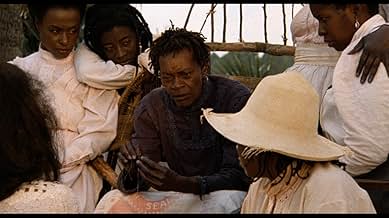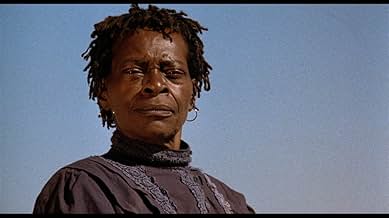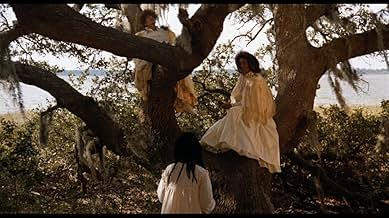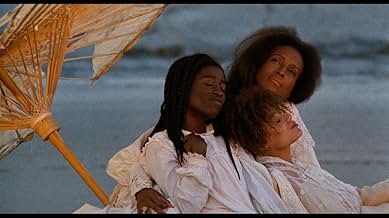Situado em 1902, dá uma olhada na cultura Gullah das ilhas do mar na costa da Carolina do Sul e da Geórgia, onde os costumes africanos permaneceram até o século XX e foi um dos últimos basti... Ler tudoSituado em 1902, dá uma olhada na cultura Gullah das ilhas do mar na costa da Carolina do Sul e da Geórgia, onde os costumes africanos permaneceram até o século XX e foi um dos últimos bastiões desses costumes em América.Situado em 1902, dá uma olhada na cultura Gullah das ilhas do mar na costa da Carolina do Sul e da Geórgia, onde os costumes africanos permaneceram até o século XX e foi um dos últimos bastiões desses costumes em América.
- Direção
- Roteirista
- Artistas
- Prêmios
- 4 vitórias e 2 indicações no total
- Yellow Mary
- (as Barbara-O)
- Newlywed Man
- (as Malik Farrakhan)
Avaliações em destaque
Now, it's not ALL bad. The movie has some cultural significance and was obviously researched before filming. The shot selection was very good, colors vibrant, and you could feel the actors' emotions.
But the story... was slow. There's a load of characters and I couldn't figure out who was related to who and what all had happened with the pregnant woman. The movie was like the opening title-card sequence to Black Hawk Down stretched out to 2 hours in length. There's parts with loads of music and no dialogue and vice versa. The movie seemed to reach an ending 5 times before it finally did. The writer-director clearly had no clue as to what pacing was.
The story was basically about some African-Americans at the turn of the century who boat down to their family on the shores of some island that is separated on one side by a river and the ocean on the other. They want a better life and are split about whether the island or the mainland is the better spot for it. It takes them two agonizing (to us) hours to decide.
Long [very long] story short: half the class walked out in the first hour. And I was jealous of those who did when I reached the end of the film. 2/10
Daughters of the Dust cannot be explained without stating the mise en cinema. From the clothing to the shots of the landscape of the island all resemble the time and place of the film. Not only the background and clothes, but also the character themselves turn this limited distributed film into a believable representation of what people of this time would act and be. The storyline background of the slavery uprising actually having taken place on the island gives it enormous creditability. The shots of the island start the creditability of the film with shots of the women interacting with the water of the ocean and the rivers, the shots of the forest and trees, and finally the most significant may be when the women are preparing the dinner showing how their food is prepared with live seafood and spices gathered from the island. The mise en cinema is creditable because of the clothes as well; from Nana who has only a dress is indigo, which was the main produce to harvest by the slaves on the island to the white Victorian dress of the women from the main land.
Dash's Daughters of the Dust cannot be denied as a cultural perspective that's originality has touched on the transition to the new culture of African Americans and they past that many have forgotten after the postwar civil war era. Its cultural insight may have been directed to a certain selected target audience, but its look into the heritage of the people cannot be viewed as anything but a respectable insight of the times.
It does however inspire me to visit the area and look into the history, but I wish the movie itself had told me more.
Kudos for the effort.
Daughters of the Dust is a film written and directed by Julie Dash. It tells the story of a family of African-Americans who have lived for many years on a Southern offshore island, and of how they come together one day in 1902 to celebrate their ancestors before some of them leave for the North. The film is narrated by an unborn child, and ancestors already dead also seem to be as present as the living.
Julie Dash underwent many hardships in bringing the story to the silver screen. She had severe budget constraints, filmed in mosquito and insect infested areas, was delayed by Hurricane Hugo, sidetracked by sudden and violent sandstorms, and was forced to decide to either have a child or make the movie. In the end, she choose to give birth and nurture the story Daugthers of the Dust and the result is an unconventional masterpiece.
Initially, the response by white male critics was not favorable and they accused Dash of not adequately explaining the Gullah people, their culture, and their religious traditions. While attacking Dash, these critics failed to acknowledge many positive aspects of the film. The reasons behind this, according to Bell Hooks, is that "we've never been taught, most of us, in any history class that black people had different languages, had different religious practices, etc. So, to some extent, the film represents that challenge to a critic of any race" to review something they are not familiar with.
Because of these reviews and the fact that movie tells the story of African American women in an unconventional manner, it would seem to have slim commercial prospects. However, through word of mouth and some positive reviews it was able to generate a cult following. To date, the film has grossed 1.6 million from a budget of only 800,000.
The Newark Black Film Festival has chosen Daughters as the Film of The Century while the British Film Institute's Sight and Sound Magazine chose the soundtrack as one of the best in the past 25 years. It also received the Best Cinematography award at the Sundance Film Festival in 1991.
I believe the film hits the viewer on various levels. By placing the story in the early 1900's, Dash is able to show us a turbulent time for African-Americans and address many issues such as migration, lynching, and the changing African-American culture. Dash also shows and teaches us about Ibo culture and it's importance in the lives of those inhabiting the Sea Coast Islands, not just the African-Americans sharing the Gullah culture, but also the Native Americans, Muslims, and Christians.
Você sabia?
- CuriosidadesSelected to the Library of Congress National Registry of Film in 2004.
- Citações
[first lines]
Nana Peazant: I am the first and the last. I am the honored one and the scorned one. I am the whore and the holy one. I am the wife and the virgin. I am the barren one and many are my daughters. I am the silence that you can not understand. I am the utterance of my name.
Principais escolhas
- How long is Daughters of the Dust?Fornecido pela Alexa
Detalhes
- Data de lançamento
- Países de origem
- Idiomas
- Também conhecido como
- Daughters of the Dust
- Locações de filme
- Empresas de produção
- Consulte mais créditos da empresa na IMDbPro
Bilheteria
- Faturamento bruto nos EUA e Canadá
- US$ 1.683.422
- Fim de semana de estreia nos EUA e Canadá
- US$ 10.842
- 20 de nov. de 2016
- Faturamento bruto mundial
- US$ 1.689.776
- Tempo de duração
- 1 h 53 min(113 min)
- Cor
- Proporção
- 1.85 : 1






























